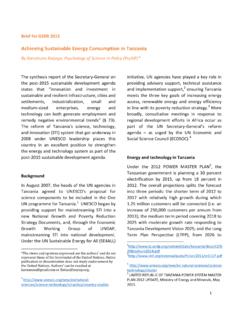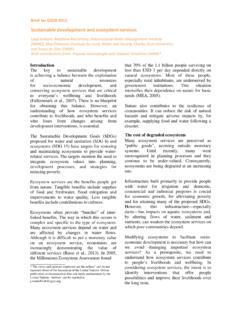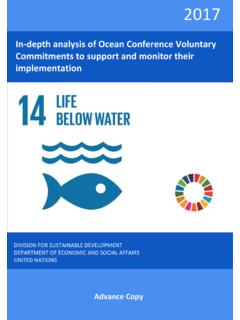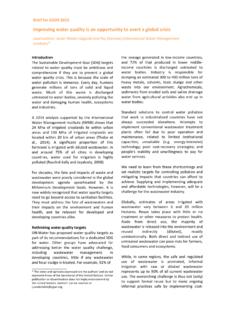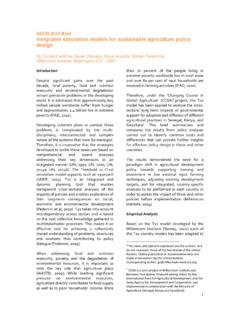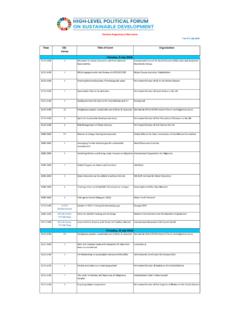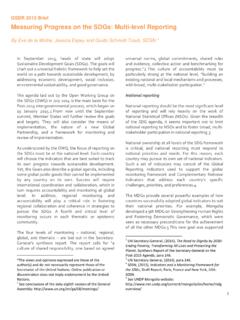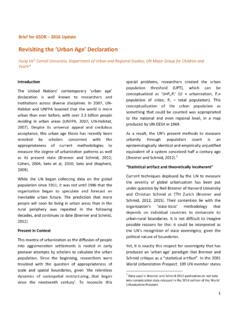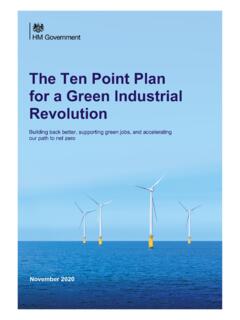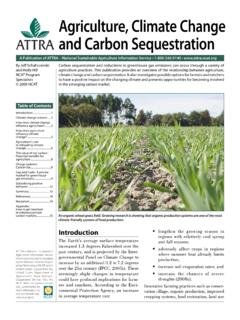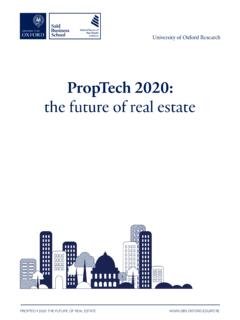Transcription of Sustainable Development in Kenya: Stocktaking in the run ...
1 Sustainable Development in kenya : Stocktaking in the run up to Rio+20. Nairobi kenya , 2012. EXECUTIVE SUMMARY. During the United Nations Conference on Environment and Development (UNCED) in Rio de Janeiro in 1992, kenya endorsed and adopted Agenda 21, which provided the world with potential practical solutions to the ever-pressing problems of the environment and Development . kenya has ratified most of the international agreements, treaties, conventions, and protocols resulting from the first Rio conference, that are considered to be in harmony with the country's plans for Sustainable Development . The most significant outcome was that kenya joined and ratified three international treaties, the United Nations Framework Convention on Climate Change (UNFCCC), whose aim is to cooperatively consider actions to limit average global temperature increases and the resulting climate change, and to cope with whatever impacts which were, by then, inevitable; the United Nations Convention on Biological Diversity (UNCBD).
2 And the UN Convention to Combat Desertification (UNCCD). As demonstration of its commitment, kenya has actively participated in international meetings convened by these conventions and hosted the second meeting of the Parties to the Kyoto Protocol (CMP 2), in conjunction with the twelfth session of the Conference of the Parties to the UNFCCC (COP 12), in Nairobi from 6 to 17 November the Rio and subsequent agreements meant undertaking certain activities and putting in place institutions to address climate change, biological diversity and combating desertification by each member country. In this Stocktaking report, kenya 's historical pursuit of Sustainable Development is traced and put in perspective from 1963 (when kenya attained independence) to present but with emphasis on the period between 1992 and 2012, which is the focus of this report.
3 kenya 's social, economic, political and environmental Development achievements made in the last 40. years and specifically the period between 1992 and present is outlined, as well as challenges facing Development . Since 1963, kenya has pursued Development that has focused on eradicating hunger, illiteracy and diseases. Sessional paper No. 1 of 1965 marked the stepping-stone for kenya 's attempts at Sustainable Development . Other relevant strategies that have been put in place include; The Poverty Reduction Strategy Paper (PRSP) in 1999; The Economic Recovery Strategy for Wealth and Employment Creation (ERS); and kenya 's Development blueprint Vision 2030. The new Constitution of kenya and relevant amendments that have been incorporated over the years, reinforce the policy and legal basis of Sustainable Development in kenya .
4 The three pillars of Sustainable Development are embedded in the fundamental rights guaranteed by the Constitution, which lay down the framework for social justice in kenya . Worth noting is that in the two decades leading to the political changes in 2002, kenya 's economy and specifically the productive sector underwent a major decline. Thus when a new government was elected in December 2002 one of the major tasks was reversing the many years of poor economic performance and weak governance. This led to the Development of the Economic Recovery Action Plan, a blueprint that was developed to guide the new government's economic policies over the following five years. The productive sectors in the context of the Economic Recovery Strategy (2003) are agriculture, tourism, trade and industry which in 2003.
5 Accounted for approximately 50 per cent of GDP, provided 628,000 formal sector jobs and million SME sector jobs while agriculture alone in the same period provided 62% of overall employment. On the social political front, kenya has enjoyed political stability despite post-election violence witnessed after the 2007 general election. The peaceful transition of power from the second President to the third President in presidential and legislative elections in December 2002. marked the beginning of a new political era by ending almost four decades of one-party rule. The new administration embarked on policies that focused on economic Development , building up the country's infrastructure, generating employment and foreign investment.
6 The economic 2. recovery strategy (2003 - 2007) targeted to achieve an 8% growth rate and industrial status for kenya by 2025, creating 500,000 jobs a year in the process. The central focus of the Plan was job creation through sound macroeconomic policies, improved governance, efficient public service delivery, an enabling environment for the private sector to do business, and through public investments and policies that reduce the cost of doing business. The Plan also included an equity and social-economic agenda focusing on reducing inequalities in access to productive resources and basic goods and services. Following the expiry of the Economic Recovery Strategy, kenya 's Development Agenda is now anchored on the kenya Vision 2030, which aims at creating a globally competitive and prosperous country with a high quality of life by 2030.
7 It aims to transform kenya into a newly industrialized, middle-income country providing a high quality of life to all its citizens in a clean and secure environment . Simultaneously, the Vision aspires to meet the Millennium Development Goals (MDGs) for Kenyans by 2015. Vision 2030's key goal is the attainment of a nation living in a clean, secure and Sustainable environment' driven by the principles of Sustainable Development . It is based on the 3 pillars of political, social and economic advancement and it aims to transform the economy and achieve Sustainable growth. Although environment does not feature in Vision 2030 as a pillar, the Kenyan Government has put in place a wide range of policy, institutional and legislative frameworks to address the major causes of environmental degradation and negative impacts on ecosystems emanating from industrial and economic Development programmes.
8 The Environmental Management and Coordination Act of 1999 (EMCA) was enacted to provide an appropriate legal and institutional framework for the management of the environment and for matters connected therewith and incidental thereto. Environmental considerations of Development are contained within the social and economic pillars. kenya is a member of the Convention of Biological Diversity (CBD), one of the outcomes of the United Nations Conference on Environment and Development held in Rio de Janeiro in 1992. kenya has also been implementing other international Development treaties like Agenda 21 and the MDGs that are inclined to environment protection and Sustainable Development . The National Environment Management Authority (NEMA), a regulatory body of the ministry of environment and mineral resources (MEMR), handles environmental coordination in kenya .
9 However, environment being a multi-sectoral phenomenon, there are several other government agencies that play a role as they manage their sectors. These include: Ministry of public health and sanitation-environmental health including; Public Health, the working environment radiation control and management of hazardous wastes; Ministry of water Development -through management of water resources utilization; Ministry of Local government-through management of urban environments by urban councils; Ministry of forestry and wild life-anti poaching and deforestation; and Ministry of Agriculture-Controls farming practices to prevent soil erosion in areas with sloppy land. The main challenges in meeting Sustainable Development and MDGs have been outlined by government as: The inadequacy of resources for financing MDGs-related activities is highlighted as the main constraint in kenya .
10 The 2007/2008 post-election violence and the recent crisis such as the food and fuel crisis present new challenges to the attainment of MDGs in kenya . Un-favourable international trade practices continue to reverse gains made by developing countries like kenya . 3. ACRONYMS. AGRA Alliance for a green revolution in Africa KKV Kazi Kwa Vijana APRs Annual Progress Reports KNASP kenya National HIV and AIDS Strategic Plan ARH&D Adolescent Reproductive Health and Development KNBS kenya National Bureau of Statistics ASALs Arid and Semi Arid Lands KNBSAP kenya National Biodiversity Strategy and Action Plan ASCU Agricultural Sector Coordination Unit KP&TC kenya Posts and Telecommunications Corporation ASDS KRDS kenya Rural Development Strategy Agricultural Sector Development Strategy BRT Bus Rapid Transit KTCIP kenya Transparency Communication Infrastructure Programme CBD Convention of Biological Diversity KTDC kenya Tourism Development Corporation CDA Coast Development Authority KVDA Kerio Valley

